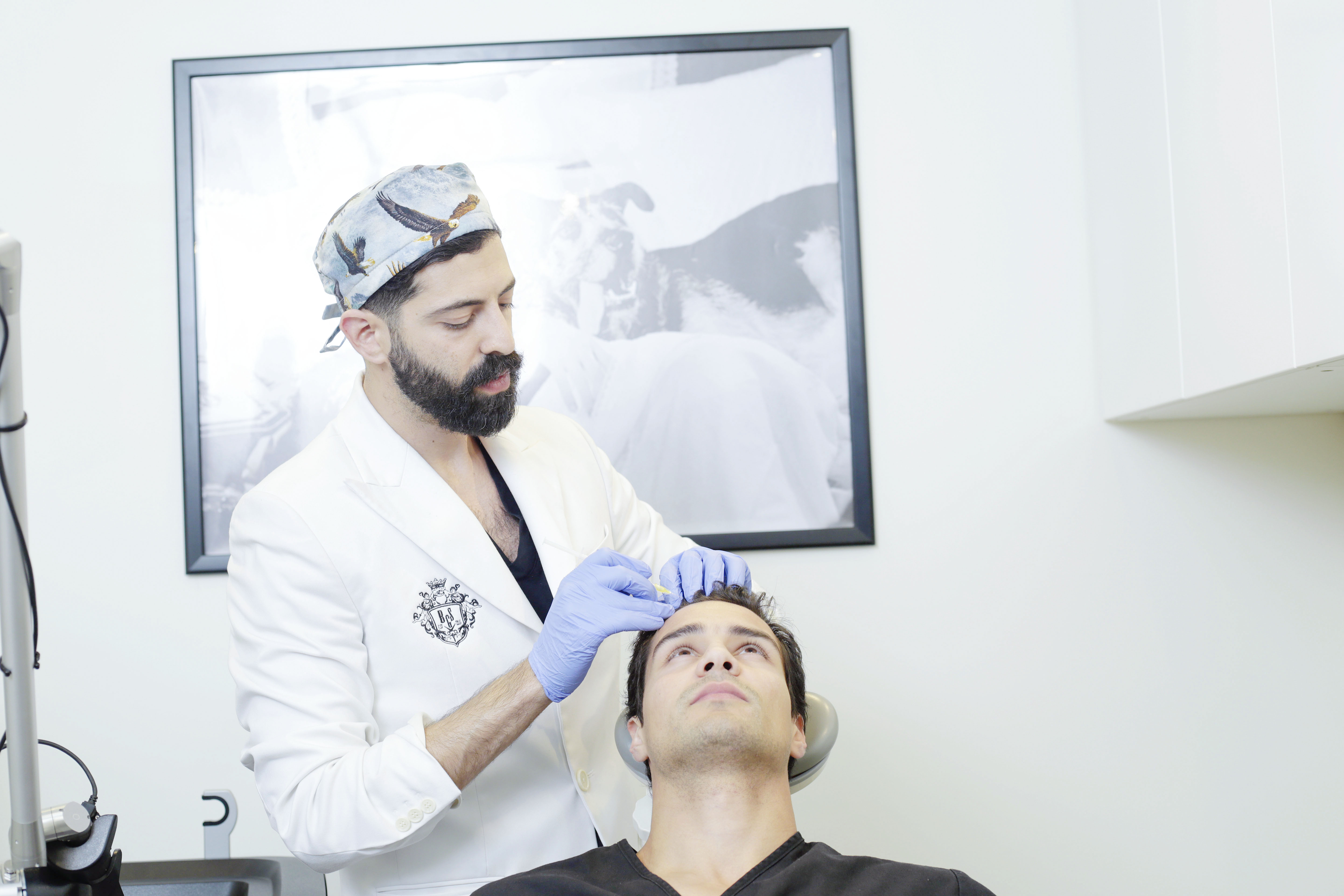
Everything You Ever Needed to Know About Hair Transplants
Everything You Need to Know About Hair Transplants
If you’ve been researching tips on how to stop from going bald, you’ve no doubt come across hair transplants as a potential solution. It’s one of the few options out there – aside from modern-day “snake oil” offerings – that gets a significant amount of attention in both the media and by consumers.
You gotta ask yourself one question, though, and it’s not whether you feel lucky (Eastwood, anyone?). That question is how much you actually know about the procedure. If you’re like most men, it’s probably not much. Fortunately, this quick guide can provide all the information you need about hair transplants.
What is a Hair Transplant?
If you’re going to make an informed decision about getting a hair transplant, you need to first understand what the procedure actually is and does. While this might sound like common sense, there is a ton of misinformation out there regarding the therapy. Here are just a few of the myths related to hair transplants:
- One day to a full head of hair: Just like your regular hair, your transplanted grafts will take time to grow. Remember, it’s real hair!
- Only men can get hair transplants: Due to the higher rate of hair loss in men, it’s understandable that fewer women get the procedure done. This doesn’t mean they’re not eligible to do so. Hair restoration isn’t sexist!
- Other people’s hair used: Some people think a hair transplant involves – or can involve – someone else’s hair. Unfortunately, your body would reject this type of transplant unless you have a genetically identical twin who iswilling to lend you some locks.
- Hair transplants are obvious: Far too many of us have the infomercial visions of terrible-looking hair plugs stuck in our heads. Fortunately, this isn’t a thing anymore. Most people will never know the difference.
In reality, a hair transplant is nothing more than removing follicles from one area of the body and placing them onto another. In most cases, the hair placed on your balding spots will come from healthier sections of your scalp. After this, the transplanted hairs will eventually fall out and be replaced by more of your own hair!
Of course, this information is the most general you’re going to get. Everything else – ranging from pricing to medically-required downtime – will vary dependent on the type of hair transplant you opt for. While these procedures may be relatively new in the history of hair restoration, they’re the most trusted out there.
Different Types of Hair Transplants
There are two different types of hair transplant procedures, and while they may have several similarities, their differences are glaring. The biggest area of distinction, though, is how follicular units of hair are harvested. You’ll hear about strip harvesting and follicular unit extraction. Don’t get excited – strip harvesting has nothing to do with stripping!
In fact, strip harvesting, aka FUT or Follicular Unit Transplant, is most often seen as the inferior method. This is because full strips of skin are removed from your scalp to harvest hair follicles. This leaves a distinctive scar and can take upwards of two weeks to recover after the surgeon sews your scalp back together. Then you have to come back to have staples or stitches removed. This is in addition to being left with a long scar on the back of your head and the potential for long-term pain and numbness.
When it comes to the FUE procedure, however, a micro removal process is utilized that leaves no linear scarring. Additionally, ARTAS robotic technology is now being utilized as a more advanced form of follicular unit extraction to ensure the best possible grafts and placement. On top of all these benefits, FUE typically takes less than a week of recovery and requires no suture removal.
Barber Surgeons Guild only uses the most advanced follicular unit extraction methods – to include ARTAS robotic hair restoration – when performing this procedure. To learn more about this method and other ways to combat hair loss, check out our Services Page. At BSG, we also include regenerative medicine measures such as PRP and ATPv with all of our robotic FUE procedures to further enhance results.
Hair Transplant Price Range
If you’ve been looking for hair transplant prices online, you’ve undoubtedly grown quite weary and probably a little frustrated. Different sites offer different advice, and some of the most informative only provide information from the United Kingdom. In reality, there’s a simple explanation behind this: hair transplant procedure costs can vary drastically.
To put things into perspective, a traditional hair transplant procedure takes between 500 and 3,000 grafts. The clinics doing this will charge anywhere from $3 to $10 per graft. This means that, on average, your procedure could cost anywhere from $1,500 (unlikely) to $30,000 (equally unlikely). It’s worth noting that strip harvesting is typically cheaper, but this is only due to the inferior nature of the procedure.
For many people considering this therapy, price simply isn’t a major consideration. After all, a full head of hair is essentially priceless. Those who need to maintain a level of financial ingenuity, however, can take a few tips from Millennial financial adviser Stefanie O’Connell. If she can teach people to live on a budget in NYC, she can certainly teach you how to save for your awesome new “do.”
If you’d like to avoid the unpredictability that comes with figuring out how many grafts are needed on the fly, Barber Surgeons Guild is the place to go. You’ll get a set price for the entire procedure – no “per follicle” fee – so there’s no worrying about whether additional grafts will be needed.
We prefer to treat patients rather than numbers, and for this reason have developed a unique fill-the-area-in pricing structure for each zone of the head being filled. We never nickel and dime our clients and include all extra therapies, such as PRP and APTv, alongside the robotic FUE procedure.
What’s the Hair Transplant Process?
Explaining two different hair transplant processes would take up a lot of time and brain power – so we’re just going to focus on the superior procedure. The ARTAS hair transplant process begins with a robotic assisted mapping of the donor site to ensure the best hair follicles to maximize growth potential. At Barber Surgeons Guild, you’ll then be given a signature haircut to ensure you get the perfect look.
After your recipient site pores are prepared, the robotically-identified donor follicles are removed and transplanted onto your thinning spots. ATP Advanced Regenerative Therapy is then utilized to enrich these follicles. This will increase the rate at which your hair grows. Platelet-rich plasma injections – which help speed up healing and increase growth rate – are also provided.
Keep in mind, ATP therapy and platelet-rich plasma injections aren’t available at every hair restoration clinic. These are always offered by Barber Surgeons Guild, though, because they improve your transplant’s potential for success. Rest assured that local anesthetic is used to knock out any pain, as is our on-demand nitrous oxide (laughing gas) system, but if you’re still worried, try some of Sara Auster’s meditative exercises before coming in!
Hair Transplant Aftercare
The first thing you need to remember following your hair transplant procedure is this: follow your doctor’s instructions. Every patient is different, and while someone may recover within two days, others may push closer to the week mark. There is no universal set of hair transplant aftercare rules, but these come pretty close:
- You’ll typically be prescribed an antibiotic to prevent any potential infections.
- Medications that minimize swelling can be provided or recommended.
- Avoid swimming pools and overexposure to sunlight.
- Don’t use hair straightening tools until your doctor says it’s safe to do so.
- Recognize that your transplant hairs will fall out before being replaced by new growth.
The last bullet point was more to ease your mind than tell you how to speed up your recovery. Whether you want to use the procedure as an excuse to skip work after downloading some great road trip songs and hitting the highway – or you just want to relax and wait for your new hair to start showing results, your doctor will give you the details.
We mentioned earlier the first thing to remember following your hair transplant. Here’s the second: follow your doctor’s directions! Yes, it’s the same directive. It’s pretty important. So do it.
Next Step: Hair Transplant
There’s probably a 5-volume set of 400-page books out there with information on hair transplants, but since you have some semblance of a life – and probably a job to get to – this quick guide should suffice. ARTAS hair transplants are your best chance at getting a full head of hair back. To find out more and learn about other hair restoration options, check out our offerings at Barber Surgeons Guild.

